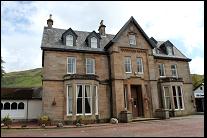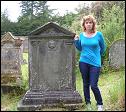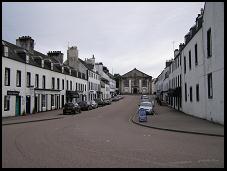The Early years of the McNeurs in Inverary
Early Scotland
|
The McFarlane connection
It seems that our family history starts with the McFarlane clan on the bank of Loch Lomond, but where they came from originally is not known.
However, in 1472 or soon after, the McFarlane, believing himself to be the true heir to the earldom of Lennox objected rather vigorously to the designation of John Stewart, Lord Darnley to the title.
The chief was killed and a large portion of the clan fled. This is probably when our ancestors moved to Inveraray.
The Scots historian, Mr Duncan Beaton, states that the McNeuirs of Glen Shira were McFarlanes, and that Alexander McNeuir and Catherine Ferguson (his wife) lived at Elrigmore in Glen Shira, a few miles north of Inveraray.
The name means the mouth of the Aray stream, Glenaray being the valley of the Aray.
|

The Claymore Hotel, Arrochar, (Loch Lomond).
Originally home to the Mcfarlane, built 1692
|
Our first traceable ancestor - John McNourure
The earliest ancestor able to be traced is John McNourure (also spelled John McNuar) who was well enough accepted in the community to be appointed keeper of the town knock (clock) in 1683 which he held for 30 years.
I will call him "John I".
The following is a copy of the Inveraray Kirk (Church) Session (Lowland) minutes for the 4th and 17th January 1683.
It is taken from the Scottish Record Office, reference CH2/633/2.
The story of John McNuar and the Town Knock.
(Taken from "The Royal Burgh of Inverary", Alexander Frader, p 163-164)
One of the ornamenta of the church of the Lowland Congregation was the knock or clock.
About this time-piece the Session deliberated long and gravely.
The knock was set in the steeple and the steeple was kept locked lest anyone might injure the mechanism.
In June 1680, David Carruders was put in charge of the knock and was paid 8 pounds
Scots betwixt Whitsunday and Martinmas: he received 6 pounds for keeping it and 2 pounds for teaching other to keep it, and to take it asunder according to the skill he had of it.
At Martinmass 1680 this commission was renewed and Carruders was provided with candle and oil and any other thing which might be necessary to keep the knock.
In January 1681, the keeper of the knock asked the Kirk Session to get leads to be weights for the knock; to close the highest windows of the steeple with boards; and to call on the person who took the lock off the back door to replace it.
In June 1681, David Carruders wished to be relieved of the responsibility of the knock.
He agreed to look after it for a fortnight longer; he was persuaded to continue in office till the following Whitsunday and to teach any two in the town who may seem to be fit for it such as John MacNuar and John Walker to work with the clock.
On 4 January 1683 a similar situation arose.
David Carudders was "desirous to lay down his charge" for keeping the town knock (clock) and was to be paid 16 pounds for the past year.
He had also received over 27 pounds previously for his fee and "things done about the knock for some other termes before this" (last two lines).
He was to keep the clock for fourteen days, until the next session meeting, which went as follows:
17 Janry Sess(ion) (no) 59
Sed(erunt) Mr John Campbell of Moy; Robert Rosse Mr Alex Duncansone Donald Morisone Robert Brown Archibald Mconlea Achibald Gillies
(In margin:) John McNuar to be the knock
According to the last sessiones appointment David Carudders having keeped the town knock to this day did earnestlie desire that his charge might be accepted off his hand and give it to another for he would not any more meddle wt (with) it: the sessione seeing him so pressing did remove the key off his hand.
After that he layed down the key being asked upon his honest word give (if) either he had wronged willfullie the knock or give (if) he knew of any of her wheel to be wrong he willinglie took it on his part of leaven (leaving) he knew nothing that was wrong in it neither did he wrong to it himself.
And (David C) being removed John McNuar was called upon as thought the fittest in the towne for this charge; who willingly did imbrace it and this samne (same) very day to enter to it;
As also the forsd (foresaid) John McNuar his incouragement and for the securite of the knock from any who might go in to the steeple to wrong it, and for the preventing of any suspicion he is desired to get ane sufficient
lock from Robert Browne to be put on the door of the steeple.
The session likewises appoints that
all things belonging to the knock be gotten from David Carruders before his charge be cleared,
And given to John McNuar his successor in office
John McNuar would have to have been born circa 1645 or earlier.
He would probably have been born in the parish of Inverary and Glenaray.
When the session was looking "to teach any two in the Town who may seem to be fit for it", he would have been about 36 years old.
He kept the clock for 30 years and probably would have stopped aged about 66 years.
He was married to Jonat Gibon who bore a son John, (John II) and that is all we know of them.
The very early records of the Parish of Inveraray and Glenaray (then joined) start in 1651.
They are faint and written in old style lettering.
There is an entry that could be the birth of a son "John McNourure and Jonat Gibon, a son John McNourure born 1668".
There were no other entries for these people in the OPR (old parish records).
There were 2 other John McNuar's in the records, but they were having children in 1681 and 1685 and therefore were probably younger than John McNourure.
The sack of Inveraray by the McDonalds under the royalist Montrose during the covenanter war would have been in John's youth and the massacre of McDonalds at Glencoe by Inveraray troops would be while he was keeper of the town knock.
|


The Inverary town clock in 2011.

Copy of original session notes,
Jan 1683.
|
John McNuar/McNourure/McNuir II
John II was born in 1668 and that is his only record in the Old Parish Records (OPR).
Other information comes from a tenancy agreement of his wife, More or Moir Morison, who he probably married before 1699 while no marriage records were being kept.
This agreement also includes their son John III and concerns a croft in the Parkhead in the common muir.
One thousand seven hundred and twenty nine years in _______ day the magistrates of the said burgh have set in tack for the tack duty under
______ to More Morison Relict to the deceased John McNuir in the Parkhead and in case of her decease to John McNuir her son that croft in the
common muir of the said burgh presently possessed by her with the houses and biggings yron and arable ground thereof and with the grazing of 4
cows, one horse, six sheep in the said common muir for the space of three years after her entry there to which hereby declared to be and begins at
the term of Whitsunday next to come 1700 and twenty nine years which tack the _______ oblige the said burgh to maintain good to the said More
Morison and in case of her decease to the said John McNuir her son provided that the grant of the said muir granted by the Duke of Argyle and his
predecessors be not recalled before the expiration of this Tack for the which causes the said John McNuir as taking burden upon him for his said
mother binds and obliges him and his heirs to pay yearly to the treasurer of the said burgh for behoof yrof the sum of six pounds six shillings and
eight pennies Scots money of rent beginning the first terms payment yrof at the term of Martinmass next to come and so forth yearly thereafter at
each term of Martinmass during the currency of this present Tack under the penalty of one pound Scots for ilk terms ______ and also the said John
McNuir binds and obliges him and his ______ to leave the houses and biggings on the said croft (suffer at his removal) all and to perform the
services of arriage and carriage watching and warding as the other tenants and possessors of the said burgh are obliged to do and consents that all
execution needful may be direct heron on a charge of five days in form as ____
I A Fisher IPC
John McNuwr
The archivist who supplied this tenancy agreement from the Burg records said that the fact the signature was on a document did not necessarily
mean that the signator was literate: rather, people practised their signature and often it was all they could write.
|
John McNuwr/McNuier III - the Post Runner
A later record includes John III and his brothers Findlay (Merchant) and Alexander (Burgess).
No record has been found of these births or any other family.
John III is one of our better documented ancestors; his signature occurs on two documents and the births or christenings of 8 children
are recorded under various surname spellings as is also his marriage to Jonat Clerk on 23 February 1725 although no record of his
own birth was found.
Jonat was born 22 May 1709, the youngest of six children of Robert Clerk and Mary McKellar of Ponymor or Penimor on
the coast of Loch Fyne several miles west of Inveraray.
The Clerks were a large and powerful family in the Inveraray district but Robert was probably one of the poorer relations.
John III figures in the tenancy agreement as the son of More Morison.
He was married in 1725, listed as a merchant in 1726, a tenant in Parkhead in 1729, and his first son John IV was
born in 1731 while he was a porter to the Duke of Argyll(1732 - 1744). He became post or runner carrying the packet
(mail) between Inveraray and Dunbarton in 1734, his second son and our ancestor Alexander was born 16/10/1742 and
he was still in Parkhead when Katherine was born in 1744.
Copy of the original, plus translation, of the authorisation for John to be post runner.
(The Latin sentence translates that as Finlay McNuier was not
present, the signature of Archibald Campbell was taken as a public notary.)
At Inveraray, the eleventh day of July 1734
The Magistrates have Admitted and Received and Authorised John McNuier in the Parkhead of Inveraray to
be their Post or Runner for carrying the packet between Inveraray and Dunbarton from this Date to the
first of July next, he always behaving himself faithfully and honestly in the said office and likewise
Ffindlay McNuier in Balenture and Alex McNuier in Inveraray his Brothers german Enact and Bind and Oblige
themselves as Cautioners for the said John McNuier that he shall behave himself faithfully and honestly
in the said office during the said space And repair all partys Damnified by his MisDemeanure or Malisfeance
therin and That under the penalty of ten pounds Sterling money by and about the Reparation of the Damages
to be Sustained by any of the Lieges thro his Default Neglect or Misconcanure in the said Office And the
said John McNuier Enacts and Obliges himself for the Relief of his said Cautioners of the premise And
they all consent that
Pounding Warding and other Execution necessary may pass hereon in form as ......
Alex McNuier
John McNuier
|

John's authorisation as a Post Runner.
|
|
Of John III's brothers, we know little. Finlay was listed as a merchant in 1720 but all we know of
Alexander is from his tombstone. The inscription reads as follows:
|
Interrerd here Alexr McNuier
Burgess in Invey
Who died 13th June 1748
aged 49 years
Erected by
John McNuier his
son, gardener in Invey
Jean McNeiladge
His spouse 1769
|

Alexander's Tombstone.
|
The stone bears crossed spades at the top appropriately enough
as his son, John V, nephew to our post runner ancestor,
became head gardener to the Duke while his aforesaid spouse,
Jean McNeilage bore 8 children in Inveraray between
1758 and 1772 followed by 4 more at Roseneath where the Duke had another castle. He would,
presumably, have laid out the new castle grounds before leaving.
|
|
|
|

Kathy McCormack,
Alex's grave 2011.
|

Annie McNeur,
Alexander's grave 2006.
|

Kathy + Samantha McCormack,
Inverary Castle
June 2011.
|
|

Inverary from the watchtower
1952 by Ian McNeur..
|

Inverary
June 2011.
|

Inverary
June 2011.
|
|
|
|
|
|